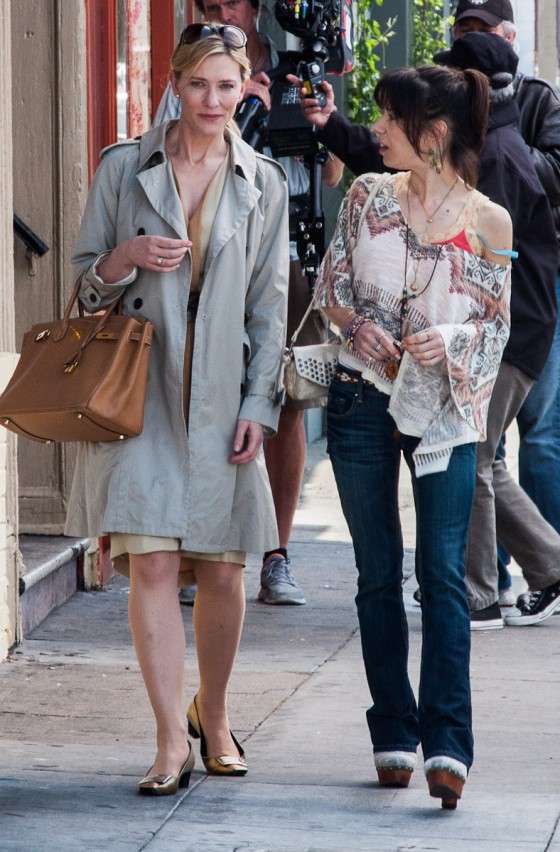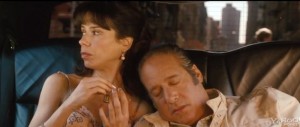 I would have been so happy to keep mum on the topic of Blue Jasmine. In the week of its release I was on vacation, confident that colleagues would cover all necessary ground without my two cents. (I’d already extensively documented my feelings about Allen’s work in the 2006 essay Hollow Wood.) But upon my return I discovered everyone falling over themselves like high school football players in high heels. Which begged the question: Were these glowing reviews of the same film I’d so blithely dismissed as Blue Jizz?
I would have been so happy to keep mum on the topic of Blue Jasmine. In the week of its release I was on vacation, confident that colleagues would cover all necessary ground without my two cents. (I’d already extensively documented my feelings about Allen’s work in the 2006 essay Hollow Wood.) But upon my return I discovered everyone falling over themselves like high school football players in high heels. Which begged the question: Were these glowing reviews of the same film I’d so blithely dismissed as Blue Jizz?
The premise itself, like too many of Allen’s post-Mia endeavors, is a meet-too-cute mashup: Call it A Streetcar Named Madoff. Cate Blanchett plays Jasmine née Jeanette, a New York socialite who’s fallen upon hard times since her charlatan of an investor husband (Alec Baldwin) left his family toe-up. After being forced to move to Brooklyn (Woody’s old-man slippers are showing), she lands upon the San Francisco stoop of her working-class sister Ginger (Sally Hawkins), whose marriage to Andrew Dice Clay ended when Jasmine’s husband swindled them out of their savings. Cue vodka-swilling, pill-popping, and smack-talking—especially when it comes to Ginger’s hotheaded beau Chili (Bobby Cannavale), who’d only be more aptly named if he actually were called Stanley.
That Blanchett actually played Blanche DuBois in a BAM production of A Streetcar Named Desire adds a curious wrinkle here. For though her characterization of Jasmine is slightly comic and slightly harrowing, mostly it is just slight—like the film itself. There’s a faintness at hand here, as if we were watching a facsimile of a facsimile.
I used to think that Woody’s work became slight when he schtupped what for all practical purposes was his stepdaughter. Now I think I gave the brother too much credit—that he was always fairly empty but once made better use of his deficiencies, better fun of them, really. Witness his classic joke: “I cheated on my metaphysics exam: I looked into the soul of the boy sitting next to me.”
In films like Annie Hall, Sleeper, Bananas, even Hannah and Her Sisters and Crimes and Misdemeanors, he struck a chord with generations who were exhausted by their search for meaning in such outlets as cult religions, fad diets, political radicalism, romantic love and, worst of all, themselves. When he made fun of himself—his ineptitude, his physicality, his neuroses—it worked. When he charismatically dictated his likes and dislikes, it worked even better. He was like an early incarnation of Pinterest, and we all fell in love with what he loved—his Central Park, his Russian tea room, his willowy crazy ladies—and we laughed at his objects of derision. (Van Gogh! Like an Arab she spoke!) Back then his hunger for meaning imparted a sort of meaning unto itself, much as a utopia can be defined by its quest for a utopia.
But his passion for the Cezanne apples in Manhattan or the Marx Brothers movie that saved his life in Hannah and Her Sisters was always as alarming as it was charming if you really parsed it out. For Woody, God wasn’t in the details so much as the details themselves were God. There really was no there there, despite how gleefully he’d attack others’ superficiality. That’s why, even early on, he could really stumble. Take Interiors, his unintentionally ironically titled 1978 Bergman-inspired exploration of three sisters. (Better he should’ve called it Details or even Surfaces.) One of his first real failures, it required a grasp of the profound despondence of his characters—a profundity that Allen could never personally achieve and thus could never grant his characters. At best he could summon a self-pitying melancholy, which read as especially foolish when lined up next to the Swedish Grandmaster of Philosophical Despair.
Still, at least back then the Artist Formerly Known as Allan Konigsberg was trying to get over himself. It’s hard to imagine him making a film today like the underrated Alice (1990), his one three-dimensional study of a character whom he loved rather than embodied. What distinguishes his work today is its utter lack of empathy. It’s better when he makes comedies rather than tragedies (a fact he unintentionally highlighted in Melinda and Melinda) but the truth is nearly everything he now writes is baldly, unapologetically, and boringly a projection of himself: his gestures, his neuroses, his desires. Even his female stand-ins—from Scarlett Johansson to Blanchett in this film—read as an echo of his own persona, albeit occasionally in forms he’d also like to fuck. That’s some serious autocinerotica right there. Or is that autocineurotica? For while a measure of introspection is intrinsic to most artistic works, only the purest narcissists create entire universes where people act and feel only as they themselves would. (Brett East Ellis’ worlds are even more charmless in this, and every, regard.) Narcissart? The wordplay possibilities are, apparently, endless.
Which brings us back to Blue Jizz. Really, it’s about as soulless as a Pat Boone record. Are we all so inured to links to links to links, references to references to references, that we’re unperturbed by this Blanchett DuBois? And are we so inured to faux depth that we give a pass to this deeply unfelt movie though it’s purportedly about big, jagged feelings? Certainly it is markedly external. In scene after scene, these characters rattle through wooden dialogue and phony setups as they might numbly recount their actions in court-ordered therapy sessions. Ginger falls for a new guy’s patter, breaks up with Chili, gets taken for a ride. Jasmine rebuffs the hamhanded advances of her dentist boss, tries to snare a rich diplomat, gets caught in her bullshit. Pops more pills.
Blanchett may be Allen’s ultimate muse. Though her technique is flawless, she often chooses to portray characters to whom she visibly condescends. The result is that, from The Aviator’s Hepburn to Notes on A Scandal’s Sheba Hart, she cultivates the deliberate cluelessness of a particular high-end femininity—and with a brittleness that is awfully meta. It’s everything Allen fears and fetishizes in both himself and in the shiksas he most desires. A superiority and inferiority complex all in one. Quel postmoderne.
Remember when Woody gave unknowns like Dianne Wiest, Daniel Stern, and Louise Lasser their big breaks? Now the biggest news of his films are the big names attached to them. For where Woody used to make actor’s careers, now they salvage his. What would Vicky Cristina Barcelona be if Penelope Cruz hadn’t hijacked it—in Spanish, no less—with her wild-fire incarnation of an artist driven mad by her broken heart? Similarly, Jasmine would stink far worse if the likes of Sally Hawkins, Andrew Dice Clay, and Louis C.K. didn’t lend so much humanity to the afterthoughts that Woody wrote for them.
 Maybe that’s why the brutes stand out in this film. For the first time in his career Allen sympathetically depicts the sort of physically imposing, working-class men he used to dismiss as thugs. Perhaps it’s because his schoolyard injuries have finally faded. Or perhaps it’s because these guys represent the “real people” who’ve been most screwed over by Wall Street shysters. Certainly the flesh and blood of Clay, Cannavale, Max Casella—their hulking forms and outsized emotions, their rapidly clenching and unclenching fists—save this film to the extent it can be saved. They provide a welcome contrapunto to all the pallid “indicating” that Blanchett, with her observations of her own observations, only perpetuates. But even this power-to-the-people storyline has no heft since Allen is patently unwilling to roll up his sleeves in the Madoff mud. His cluelessness may be as cultivated as Blanchett’s.
Maybe that’s why the brutes stand out in this film. For the first time in his career Allen sympathetically depicts the sort of physically imposing, working-class men he used to dismiss as thugs. Perhaps it’s because his schoolyard injuries have finally faded. Or perhaps it’s because these guys represent the “real people” who’ve been most screwed over by Wall Street shysters. Certainly the flesh and blood of Clay, Cannavale, Max Casella—their hulking forms and outsized emotions, their rapidly clenching and unclenching fists—save this film to the extent it can be saved. They provide a welcome contrapunto to all the pallid “indicating” that Blanchett, with her observations of her own observations, only perpetuates. But even this power-to-the-people storyline has no heft since Allen is patently unwilling to roll up his sleeves in the Madoff mud. His cluelessness may be as cultivated as Blanchett’s.
Ultimately, nothing can save this slight of hand from itself. If it weren’t a Woody Allen project peopled with some of today’s most beloved actors, it’d be another what’s-it-all-about indie eternally doomed to the festival circuit. Oy, oy. That he has become a man of our time speaks more of our time than of Allen’s evolution for our Wood is as hollow as he ever was.
